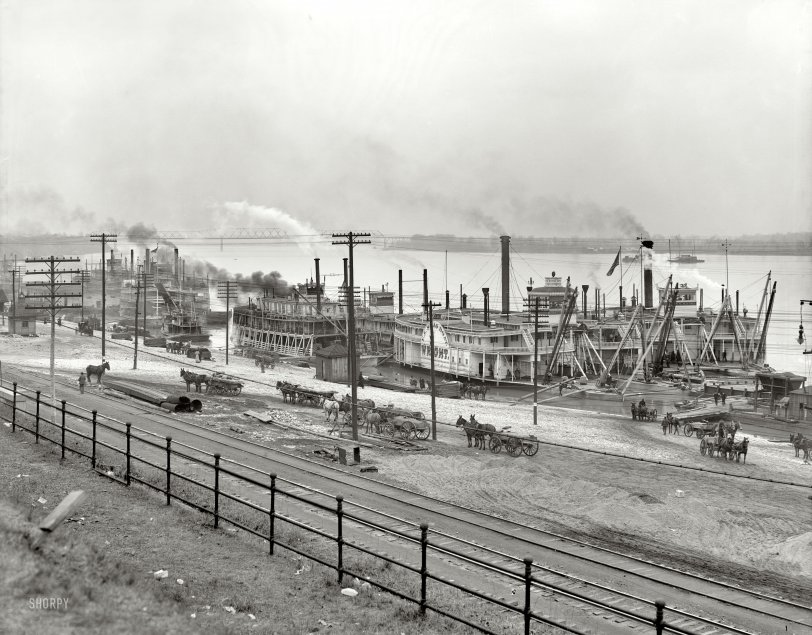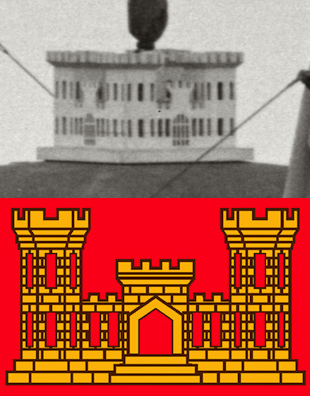


Framed or unframed, desk size to sofa size, printed by us in Arizona and Alabama since 2007. Explore now.
Shorpy is funded by you. Patreon contributors get an ad-free experience.
Learn more.

- If You’re Like Me, Never
- U.S.A.
- S&P
- 1940 Zenith radio model 6G601
- Quality goes in before the name goes on!
- Snazzy skirt
- Carbon Arc Lamps
- Illuminate us
- I remember it well
- I can't prove it
- Complicated then, forgotten now
- Bryan-Stevenson
- Skinny is as skinny does
- How do you rest in peace
- Riding the footboards
- Alas, hidden from view
- Baldwin Diesels
- Exclusive pump
- Bananas, Oysters and Smokey Joe
- Details, Details
- What's that building to the left of the tower?
- Coal Barges
- Bromo-Seltzer
- Inner harbor
- The Basin
- What a headache!
- Giant stepladder?
- Yeah, it was cold
- Love those coats
- Link & Pin Days Remnant
Print Emporium
Memphis: 1906

Memphis, Tennessee, circa 1906. "Mississippi River levee from the bluff." 8x10 inch dry plate glass negative, Detroit Publishing Company. View full size.
Port and Starboard.
I notice that most of the two side-by-side funnels on paddle steamers shown throughout the Shorpy site have a J-shaped bracket at the top of each funnel with small pulleys at the outer end of the J with lanyards to the deck below so that illuminated coloured lanterns can be hoisted to the funnel tops at night.
This would indicate whether the steamer in the distance is approaching or going away as seen from the pilot house on the steamer you were on.
I presume the lanterns would be green for right/starboard and red for left/port side as per salt water rules.
On the stern of the 'Transit' in the lock shown elsewhere at Shorpy, there are two small boxes with side doors at the stern above the paddle wheel which have stern lanterns within.
Thank You.
Tinted
Here's Detroit Publishing Company's 1906 colorized postcard from the same image.
Bridge
The Frisco Bridge seen in the background was built in 1892,at that time it was the only bridge across the Mississippi south of St. Louis, it is still in use today and has always been a railway bridge.
Snagboat history
All U.S. snagboats are based on the Heliopolis, built in 1837 by Henry M. Shreve. The largest crane currently operated by the COE is also named for Shreve.
Wow!
Wow, what a shot! My grandfather Henry Schmidt on my mom's side was an engineer on the Horatio Wright at this time. Mom was a year old or less when this was taken. Thank you!
Snag Boats
Excellent view of two snag boats. Their duty was to remove snags (hazards to navigation, usually sunken logs) from the river. The split bow allowed them to get over the snag and then lift it out of the water with the A-frame crane.
Mark Twain's river mentor
The Horatio Wright was captained by none other than super-pilot Horace Bixby from Mark Twain's "Life on the Mississippi"!
An interview with him was published in Waterways Journal in April 1910, just four years after this picture was taken:
HOW MARK TWAIN GOT ON THE RIVER.
Among those who are competent to give personal reminiscences of Mark Twain are Capt. Horace Ezza [sic] Bixby, probably knew the humorist earlier than anyone now living in St. Louis, and doubtless knew Clemens, the pilot, better than any other man now living.
Capt. Bixby is pilot of the United States snagboat Wright at the age of 84 years. He resides with his son-in-law, Dr. Louis T. Pim, 5910 Etzel avenue. Capt. Bixby "learned" Clemens the river from St. Louis to New Orleans, and although they saw each other little since 1861, the captain cherishes his recollections fondly.
In Memphis one time, he told a reporter that he wished Mark Twain were dead so he wouldn't be bothered in retailing reminiscences about him longer. He was annoyed when the remark was printed, but there is no record that Mark Twain ever heard of it, and if he had, it was just the sort of a whimsicality that he would have appreciated. But when Mark Twain hung on the brink of the beyond, a flood of recollections came to the captain, and looking out over the green lawns he saw the little dingy pilot house of the Paul Jones, with a lank young fellow standing in the doorway saying in that enduring drawl: "Say, will -- you -- teach -- me -- the river?"
The age of horse and steam
It is only by seeing these pictures that you realise how much the world continued to rely on horsepower and steam power to drive the economy for much of the first half of the 20th century. A fascinating picture full of life.
Snaggers
The heavy A-frames and tackle were used to remove snags, large trees that had washed down the river until one end grounded out. The trees would remain there, bobbing up and down in the current, thus often called "sawyers" after the motion of the sawyer at the top of a pit saw. (The guy down below eating sawdust was the "pitman", later replaced by a lever mechanism of the same name, yielding an automotive term still in use -- pitman arm.)
Such a snag could tear the bottom out of a wooden boat, so needed to be removed by a snag boat as soon as possible.
Note the C.O.E. castle logo atop the wheelhouse of the Horatio Wright. Elsewhere on Shorpy are Civil War Engineers with the same castle badge.
There is a fiddle tune named "Mississippi Sawyer", named for the motion of the fiddler's elbow, "rockin the bow."
All Snaggled Up
I can't say about the others, but the four boats on the right look to be snag boats run by the US Army Corps of Engineers. The name of the boat on the far right, the John N. Macomb, tipped me off. I thought I was clever until I read US Snag Boat Wright on the paddle of the left-most in the group.
Snag boats were used by the Corps for decades to remove debris from those river courses which were once important to interstate commerce. Lots of stuff on Google about them. If you're interested, the snagboat Montgomery http://montgomery.sam.usace.army.mil/about.html is an historical monument, and you can tour the old tub way down in Alabamy.
By the way, the Macomb was named after Col. John N. Macomb. Macomb was a graduate of West Point, and apparently a member, like John C. Fremont, of the Corp of Topographical Engineers. His claim to fame was his exploration of the canyon lands of the Colorado River, in the four corners region. (There are books with photos--look it up.) He was also a Civil War balloonist and apparently served in the Mexican War, too. Quite a career.
Horatio G. Wright was a general officer in the Corps of Engineers. I haven't found much about him. Maybe another reader can enlighten us. But it looks like the Corps like to name their boats after engineers in the Corps. Surprise.
Corps of Engineers
I love the fact that the Horatio Wright wheelhouse is topped by a wonderful model of the Army Corps of Engineers' famous castle insignia.

























On Shorpy:
Today’s Top 5